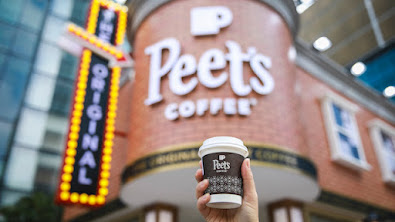Restaurants are not great investments. Restaurant chains need a lot of staff, kitchen equipment and retail space for every new outlet. It is not the kind of business that gets easier as it gets bigger. This makes growth expensive. You can see that in the ROI results of restaurants, which are relatively low compared to sectors such as healthcare and consumer staples.
Greggs PLC is a British chain that sells bakery products, such as sausage rolls, baguettes, wraps and toast. You typically buy those with a drink for on-the-go, but many Greggs outlets will also have a few chairs and tables for dine-in. The products are affordable for any budget. Like all restaurants, Greggs suffered from the covid lockdowns. I bought the share in 2022 and got lucky that the lockdowns ended soon after my buy. The share price went up quickly, so I did not even have the chance to top it up to a full holding.
Selling Greggs now could be a big mistake. The brand is a cult hit within the UK. There is some speculation about expanding the brand to other countries. I could see that becoming successful. On the other hand, restaurants often fail when moving into new markets. There may be cultural differences, making the concept unattractive to locals. Existing dining concepts could also have saturated the market already. After considering all this, I decided to sell Greggs. I am trying to free up cash for investments in my main focus area, consumer staples. I am also reducing the amount of holdings in my portfolio.
Both reasons also apply to my selling of Grupo Ibersol SGPS SA (LIS:IBS). Ibersol runs fast-food and casual restaurants such as Pizza Hut, KFC, Taco Bell, Pasta Caffe, Pans & Company and Ribs within Portugal, Spain and Angola (two KFC outlets). For the first three formulas, Ibersol is a franchisee of Yum! Brands. The latter three are its own brands.
Like Greggs, Ibersol got into trouble due to the Covid lockdowns. It had to issue new shares and sell its Burger King division with 158 restaurants. When the lockdowns ended, Ibersol appeared to have overreached with these actions and had a huge cash balance. I bought the share at 7.00 euros, with Ibersol holding 5.58 euros per share in cash on the balance sheet. It is now using this for share buybacks. It also plans to open 70 Pret-a-Mangers, where they will sell, tasty but expensive, sandwiches and coffee on-the-go. Ibersol obtained the Pret-a-Manger franchisee rights for Spain and Portugal. There are a few finance bloggers who tell the whole Ibersol story much better than me: Carsten Mueller, Gonçalo Garcia, Corner of Berkshire and Fairfax Forum (pay-wall).
So far, Ibersol's expansion plans and buybacks have not impacted the share price much. I lost my patience and sold out of Ibersol again. Like Greggs, selling could prove to be a big mistake. Ibersol seems to be a deep-value opportunity. However, I am dedicated to reorganizing my portfolio around consumer staples. In addition, Portugal has a 25% withholding tax on dividends, which I can not claim back. This makes it somewhat painful to hold Portuguese shares in the long run. Now, admittedly, Ibersol does not pay out much dividends. It prefers to retain earnings for investments in expansion. This, however, raises another issue. Your investment is stuck within the company and you have to hope for Mr Market bidding up the share price to reflect Ibersol's growth. Unfortunately, Ibersol does not grow as fast as tech or AI and the Portuguese market does not have the attention of many investors.
Ibersol's ROIC is usually around 7%, which can drop quickly to 3% in slow years. Like many restaurant chains, the business is stable, but profitability is also limited. Perhaps that is why Warren Buffett never invested in restaurants, except for Dairy Queen. Still, DQ only runs a limited amount of outlets. Its main role is as the franchisor of the brand.
Talking about super-investors, let me conclude with some remarks made by Li Lu about the restaurant business in general. He talks about another risk threatening the restaurant business: obsolescence. Although dining trends may not affect Greggs and Ibersol that quickly, it is still a concern for long-term investment.
Can you please tell us what are the most important sources of a company’s moat? Is it a brand, the management team or its business model? What types of moat do you value most?
Li Lu: This all depends on your investment horizon. The longer your investment horizon, the more important industry dynamics become for protecting your moat. The shorter your investment horizon, the more important people become.
The source of each industry and each company’s competitive advantage will be different, as will the degree to which they can protect their moat. We hold ourselves to the same standards and use the same analytical methods when looking at each industry. However, after spending much time on our research, we ultimately reached the conclusion that most companies are too hard and predictions about them cannot be made. The changes in many companies themselves do not make for sustainable competitiveness. Take the simplest example, restaurants. At any time, there will always be a group of restaurants in Beijing with the best business. And some cuisine will always be the most popular. However, you will see that after not too long, these will change. Because even though they’re doing well now, it’s hard to guarantee that they will still be in the future. You can spend a lot of time on industries like this and ultimately realise the same thing: they are too hard to predict.
https://www.longriverinv.com/thought/qampa-with-li-lu
(Li Lu, Himalaya Capital, Speech: "The Practice of Value Investing”, November 2019, Peking University Guanghua School of Management.)











